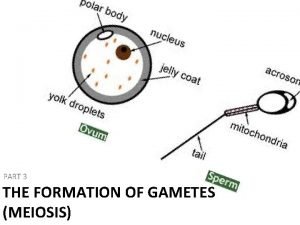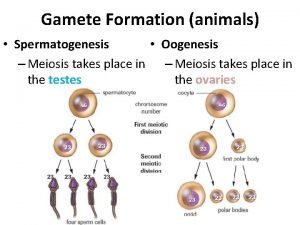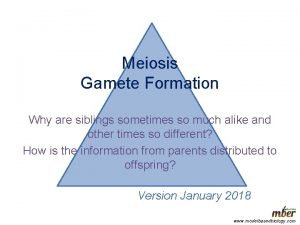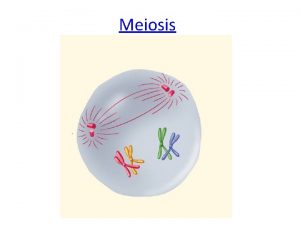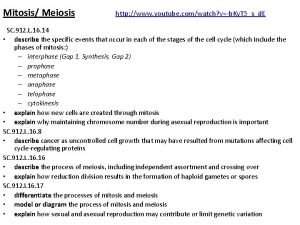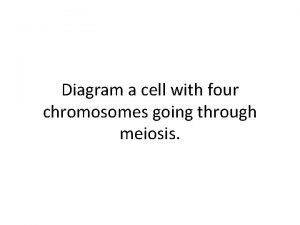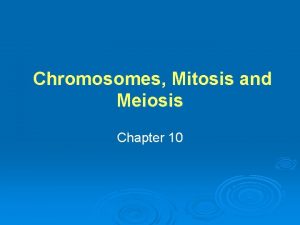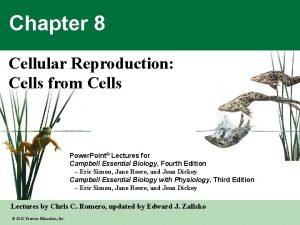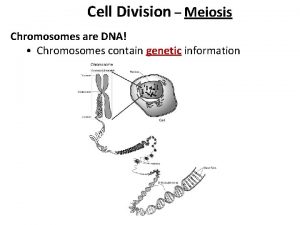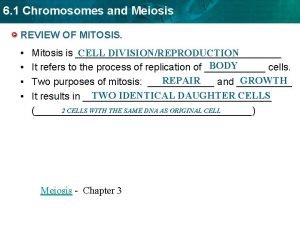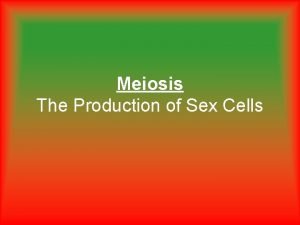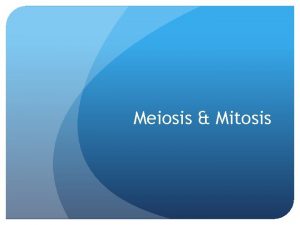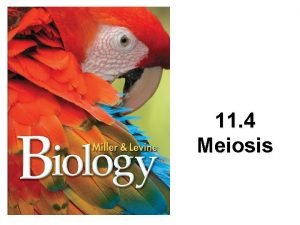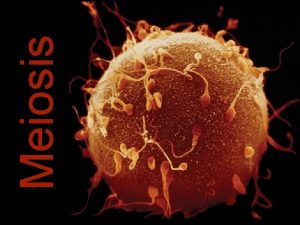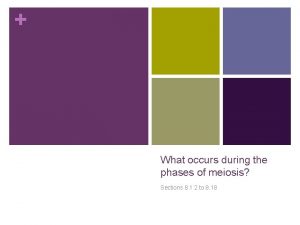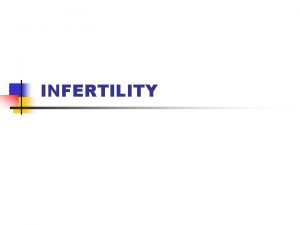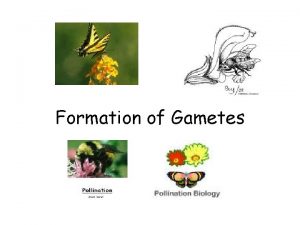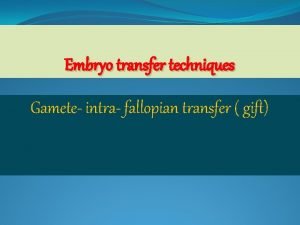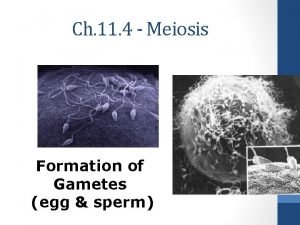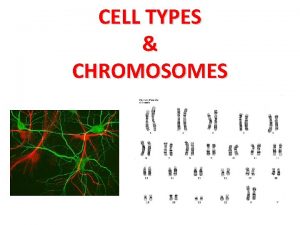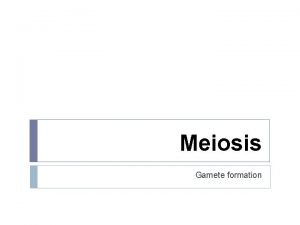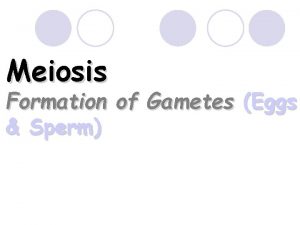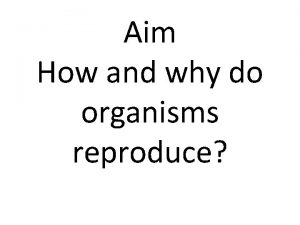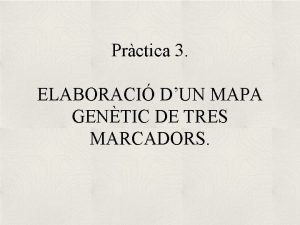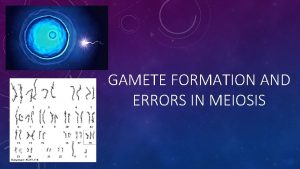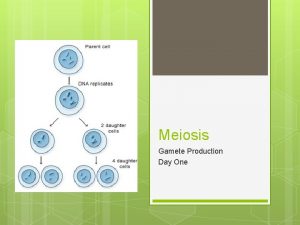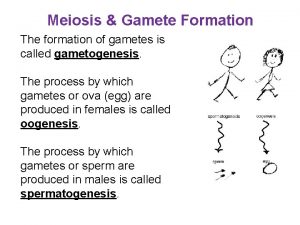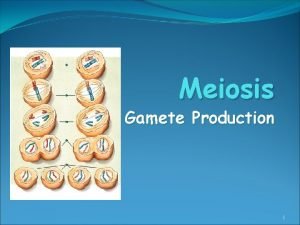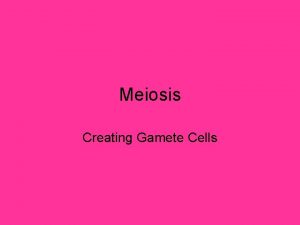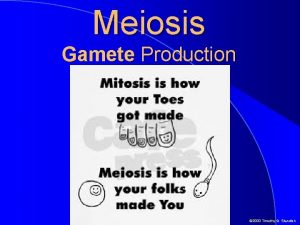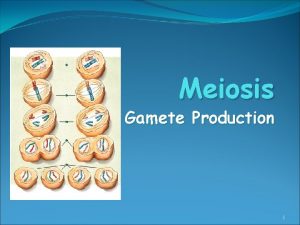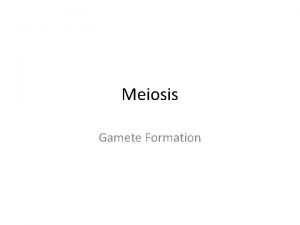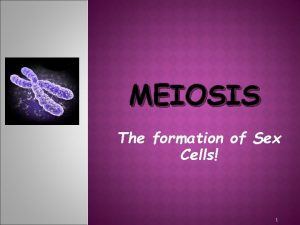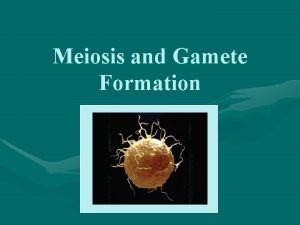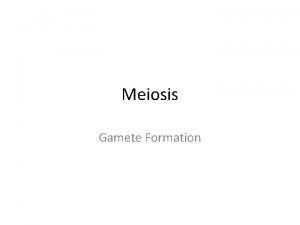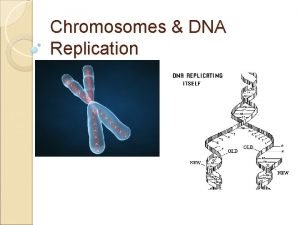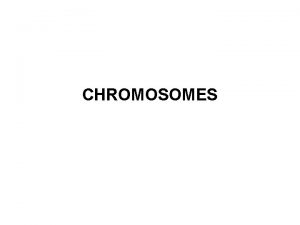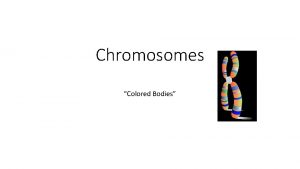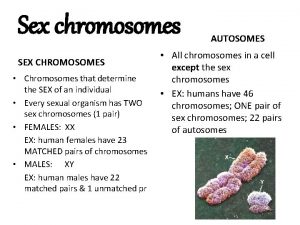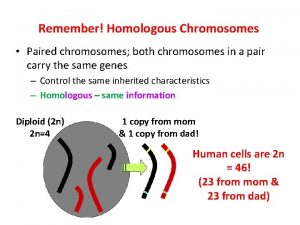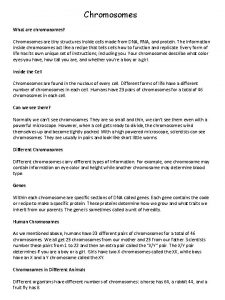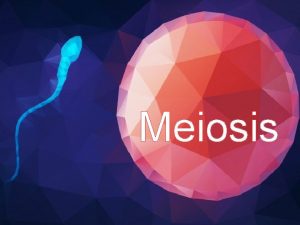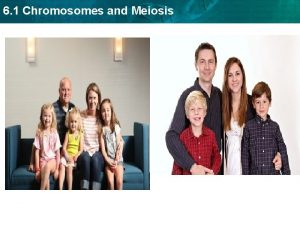Topic 3 Meiosis gamete formation Human chromosomes Human

































- Slides: 33

Topic 3 Meiosis (gamete formation)

Human chromosomes • Human somatic cells (any cell other than a gamete) have: • 22 pairs of homologous chromosomes • 1 pair of sex chromosomes • 46 individual chromosomes • Individuals inherit one set from each parent Copyright © 2008 Pearson Education, Inc. , publishing as Pearson Benjamin Cummings

Human chromosomes • The sex chromosomes are called X and Y • Human females have a homologous pair of X chromosomes (XX) • Human males have one X and one Y chromosome, which is much smaller than an X chromosome • The 22 pairs of chromosomes that do not determine sex are called …? • Are these chromosomes from a male or female? • How do you know? Sex chromosomes Copyright © 2008 Pearson Education, Inc. , publishing as Pearson Benjamin Cummings

How we describe cellular chromosome number Humans Diploid (2 n) lll ll l Chromosome # = 6 Cells with 2 complete sets of chromosomes (1 set from mom, 1 set from dad – pairs!…this means that you have 2 versions of every gene. ) Human gametes (sex cells) Haploid (n) l l l Chromosome # = 3 Cells with 1 complete set of chromosomes (only one of each gene)

Human gametes (n) are combined for reproduction. sperm n=23 egg Fertilization The fertilized egg is now 2 n and is called a zygote. 2 n=46 zygote 5

Meiosis & Sexual Reproduction

Double division of meiosis DNA replication 1 st division of meiosis separates homologous pairs 2 nd division of meiosis separates sister chromatids Meiosis 1 Meiosis 2

Figure 13. 7 The stages of meiotic cell division: Meiosis I OBJ 15 8

Figure 13. 7 The stages of meiotic cell division: Meiosis II OBJ 15 9

Trading pieces of DNA creates variation l. Crossing over ¡during Prophase 1, sister chromatids of homologous chromosomes intertwine lhomologous pairs swap pieces of chromosome • DNA breaks & re-attaches tetrad prophase 1

Variation from: l Independent assortment of chromosomes ¡gametes of offspring do not have same combination of genes as gametes from parents lrandom assortment in humans produces 223 (8, 388, 608) different combinations in gametes from Mom from Dad offspring new gametes made by offspring

Mitosis vs. Meiosis

Gametogenesis in humans l Oogenesis: formation of eggs l Spermatogenesis: formation of sperm l Occurs in the reproductive organs

Oogenesis ¡ During fetal development, oocyte pauses after Prophase I ¡ Meiosis 1 completed during maturation ¡ Meiosis 2 pauses in Metaphase II ¡ Meiosis 2 completed after release from ovary

Sperm production

Variation from random fertilization l Sperm + Egg = ? ¡any 2 parents will produce a zygote with over 70 trillion (223 x 223) possible diploid combinations

Sexual reproduction creates variability Sexual reproduction allows us to maintain both genetic similarity & differences.

When meiosis goes wrong: chromosomal disorders

Human chromosomes review • The sex chromosomes are called X and Y • Human females have a homologous pair of X chromosomes (XX) • Human males have one X and one Y chromosome, which is much smaller than an X chromosome • The 22 pairs of chromosomes that do not determine sex are called autosomes Sex chromosomes Copyright © 2008 Pearson Education, Inc. , publishing as Pearson Benjamin Cummings

ACTIVITY INTERLUDE

Copyright © 2008 Pearson Education, Inc. , publishing as Pearson Benjamin Cummings

Karyotype review • A karyotype is an ordered display of the pairs of chromosomes from a cell • Karyotypes can tell us the sex of a fetus • Karyotypes can also tell us if there are chromosomal abnormalities • Autosomal disorders result from extra autosomal chromosomes • Sex chromosome disorders result from extra sex chromosomes Copyright © 2008 Pearson Education, Inc. , publishing as Pearson Benjamin Cummings

Chromosomal disorders l Result from errors during meiosis ¡ Abnormal number of chromosomes (nondisjunction) l Chromosomes fail to separate (either during meiosis 1 or meiosis 2) l Usually fatal if an autosome l Usually nonfatal if a sex chromosome (if there is at least one X) ¡ Missing bits of chromosome (deletion) ¡ Crossing over with nonhomologous chromosomes (translocation)

ACTIVITY INTERLUDE

Patient A

Patient B

Patient C

What’s the diagnosis? l Patient A: Klinefelter’s syndrome ¡Extra sex chromosome (XXY) l Patient B: Patau syndrome (trisomy 13) ¡Extra autosomal chromosome 13 l Patient C: Down’s syndrome (trisomy 21) ¡Extra autosomal chromosome 21


Variation from: l Crossing over: creates completely new combinations of traits on each chromosome ¡Can create an infinite variety in gametes

Sperm production Epididymis Testis Coiled seminiferous tubules germ cell (diploid) primary spermatocyte (diploid) MEIOSIS I secondary spermatocytes (haploid) Vas deferens spermatids (haploid) spermatozoa Cross-section of seminiferous tubule MEIOSIS II

Oogenesis germinal cell (diploid) primary follicles fallopian tube fertilization primary oocyte (diploid) MEIOSIS I secondary oocyte (haploid) first polar body MEIOSIS II second polar body ovum (haploid) developing follicle mature follicle with secondary oocyte ruptured follicle (ovulation) corpus luteum

The value of sexual reproduction l Sexual reproduction introduces genetic variation ¡genetic recombination lindependent assortment of chromosomes lcrossing over ¡random fertilization l Providing variation for natural selection metaphase 1
 Crossing over occurs during:
Crossing over occurs during: Spermatogenesis vs oogenesis
Spermatogenesis vs oogenesis Meiosis
Meiosis Lucy and maria twins
Lucy and maria twins What are gametes
What are gametes Mitosis meiosis
Mitosis meiosis Chromosomes number is maintained mitosis or meiosis
Chromosomes number is maintained mitosis or meiosis End of mitosis
End of mitosis Synapsis of homologous chromosomes in meiosis
Synapsis of homologous chromosomes in meiosis Sister chromatids separate from each other
Sister chromatids separate from each other Crossing over meiosis
Crossing over meiosis Chromosomes number is maintained mitosis or meiosis
Chromosomes number is maintained mitosis or meiosis How many chromosomes does a human have
How many chromosomes does a human have How many daughter cells are formed in meiosis? *
How many daughter cells are formed in meiosis? * Miller and levine biology textbook
Miller and levine biology textbook Diagrams of mitosis
Diagrams of mitosis Anaphase in meiosis vs mitosis
Anaphase in meiosis vs mitosis Meiosis and genetic variation answer key
Meiosis and genetic variation answer key Chromosome disability
Chromosome disability Study guide chapter 10 section 1 meiosis
Study guide chapter 10 section 1 meiosis Chapter 10 section 1 meiosis
Chapter 10 section 1 meiosis Prophase 1
Prophase 1 Gamete and zygote
Gamete and zygote Haploid and diploid venn diagram
Haploid and diploid venn diagram Gamete intrafallopian transfer
Gamete intrafallopian transfer What is gamete
What is gamete Gamete intrafallopian transfer
Gamete intrafallopian transfer Law of segregation vs law of independent assortment
Law of segregation vs law of independent assortment Diploid cell
Diploid cell Gamete
Gamete Mitosis facts
Mitosis facts Gametophytes have gamete-producing organs called _____.
Gametophytes have gamete-producing organs called _____. Female gamete
Female gamete Gàmete
Gàmete
